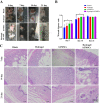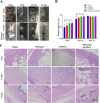A hybrid hydrogel encapsulating human umbilical cord mesenchymal stem cells enhances diabetic wound healing
- PMID: 35849219
- PMCID: PMC9293866
- DOI: 10.1007/s10856-022-06681-4
A hybrid hydrogel encapsulating human umbilical cord mesenchymal stem cells enhances diabetic wound healing
Abstract
Background: Diabetic wound is a severe complication of diabetes. Stem cell is considered as a promising therapy for diabetic skin wounds. Hydrogel can supply niche for cells adhesion and survival to improve the efficacy of stem cell therapy, but the development of hydrogel with suitable properties remains a great challenge. Thus, our study was conducted to combine an optimized hydrogel with stem cell to improve complex diabetic wound treatment.
Methods: This study constructed a hydrogel with low toxicity and adjustable mechanical properties from gelatin methacrylate (GelMA) and chitosan-catechol (Chi-C), and encapsulated human umbilical cord-mesenchymal stem cells (hUMSCs) to repair full-thickness diabetic wound.
Results: We explored the relationship between mechanical stiffness and cell proliferation and differentiation potency, and found 10% GelMA hydrogel with an optimal stiffness improved hUMSCs adhesion, proliferation, and differentiation potency maintenance in vitro. Assistant with optimized hydrogel encapsulating hUMSCs, diabetic wound healing process was greatly accelerated, including accelerated wound closure, inhibited secretion of inflammatory factors TNF-α and IL-1β, promoted vascular regeneration and collagen deposition after treatment of hUMSCs.
Conclusions: The optimized hydrogel encapsulating hUMSCs improved diabetic wound healing, and has a broad implication for the treatment of diabetic complication. Diabetic wound is a severe complication of diabetes. Stem cell is considered as a promising therapy for diabetic skin wounds. Hydrogel can supply niche for cells adhesion and survival to improve the efficacy of stem cell therapy. This study constructed a hydrogel with low toxicity and adjustable mechanical properties from gelatin methacrylate (GelMA) and chitosan-catechol (Chi-C), and encapsulated human umbilical cord-mesenchymal stem cells (hUMSCs) to repair full-thickness diabetic wound. Hydrogel of 10% GelMA with an optimal stiffness improved hUMSCs adhesion, proliferation, and differentiation potency maintenance in vitro. Assistant with optimized hydrogel encapsulating hUMSCs, diabetic wound healing process was greatly accelerated, including accelerated wound closure, inhibited secretion of inflammatory factors TNF-α and IL-1β, promoted vascular regeneration and collagen deposition after treatment of hUMSCs. The study supplies an alternative treatment for diabetic complication. Hydrogel-hUMSCs combined treatment accelerates wound closure in diabetic mice. A. Representative images of wounds during 21-day in vivo experiments. B. Quantification of wound closure rate (%) over 21-day period. C. HE staining of wounds at days 7, 14 and 21. The bar corresponds to 200 μm.
© 2022. The Author(s).
Conflict of interest statement
The authors declare no competing interests.
Figures









Similar articles
-
[Effects of gelatin methacrylate anhydride hydrogel loaded with small extracellular vesicles derived from human umbilical cord mesenchymal stem cells in the treatment of full-thickness skin defect wounds in mice].Zhonghua Shao Shang Yu Chuang Mian Xiu Fu Za Zhi. 2024 Apr 20;40(4):323-332. doi: 10.3760/cma.j.cn501225-20231218-00248. Zhonghua Shao Shang Yu Chuang Mian Xiu Fu Za Zhi. 2024. PMID: 38664026 Free PMC article. Chinese.
-
Enhanced cutaneous wound healing by functional injectable thermo-sensitive chitosan-based hydrogel encapsulated human umbilical cord-mesenchymal stem cells.Int J Biol Macromol. 2019 Sep 15;137:433-441. doi: 10.1016/j.ijbiomac.2019.06.246. Epub 2019 Jul 2. Int J Biol Macromol. 2019. PMID: 31271797
-
Umbilical Cord-Derived Mesenchymal Stem Cell-Derived Exosomes Combined Pluronic F127 Hydrogel Promote Chronic Diabetic Wound Healing and Complete Skin Regeneration.Int J Nanomedicine. 2020 Aug 11;15:5911-5926. doi: 10.2147/IJN.S249129. eCollection 2020. Int J Nanomedicine. 2020. PMID: 32848396 Free PMC article.
-
Supporting wound healing by mesenchymal stem cells (MSCs) therapy in combination with scaffold, hydrogel, and matrix; State of the art.Pathol Res Pract. 2023 Aug;248:154575. doi: 10.1016/j.prp.2023.154575. Epub 2023 May 26. Pathol Res Pract. 2023. PMID: 37285734 Review.
-
Umbilical cord mesenchymal stem cells combined with autologous platelet-rich plasma for lower extremity venous ulcers: A case report and literature review.Medicine (Baltimore). 2024 Nov 8;103(45):e40433. doi: 10.1097/MD.0000000000040433. Medicine (Baltimore). 2024. PMID: 39533589 Free PMC article. Review.
Cited by
-
Mesenchymal Stem Cells-based Cell-free Therapy Targeting Neuroinflammation.Aging Dis. 2024 May 7;15(3):965-976. doi: 10.14336/AD.2023.0904. Aging Dis. 2024. PMID: 38722791 Free PMC article. Review.
-
Tissue-Engineered Injectable Gelatin-Methacryloyl Hydrogel-Based Adjunctive Therapy for Intervertebral Disc Degeneration.ACS Omega. 2023 Apr 7;8(15):13509-13518. doi: 10.1021/acsomega.3c00211. eCollection 2023 Apr 18. ACS Omega. 2023. PMID: 37091429 Free PMC article. Review.
-
Biomimetic scaffolds loaded with mesenchymal stem cells (MSCs) or MSC-derived exosomes for enhanced wound healing.Stem Cell Res Ther. 2024 Nov 9;15(1):406. doi: 10.1186/s13287-024-04012-8. Stem Cell Res Ther. 2024. PMID: 39522032 Free PMC article. Review.
-
Functional hydrogels for the repair and regeneration of tissue defects.Front Bioeng Biotechnol. 2023 May 16;11:1190171. doi: 10.3389/fbioe.2023.1190171. eCollection 2023. Front Bioeng Biotechnol. 2023. PMID: 37260829 Free PMC article. Review.
-
Exosomal microRNAs from Mesenchymal Stem Cells: Novel Therapeutic Effect in Wound Healing.Tissue Eng Regen Med. 2023 Aug;20(5):647-660. doi: 10.1007/s13770-023-00542-z. Epub 2023 May 2. Tissue Eng Regen Med. 2023. PMID: 37131016 Free PMC article. Review.
References
-
- Fritschi C. Preventive care of the diabetic foot. Nurs Clin North Am. 2001;36:303–20. - PubMed
MeSH terms
Substances
Grants and funding
LinkOut - more resources
Full Text Sources
Other Literature Sources

